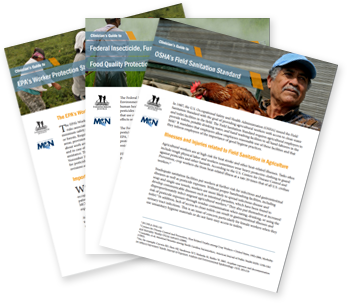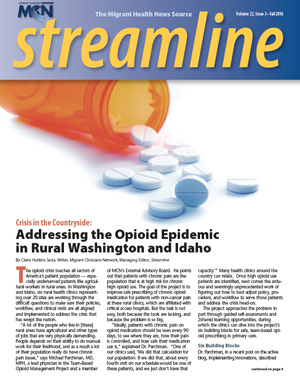Newly Updated Clinician’s Guides: How Policy Affects the Health of Agricultural Workers

[Editor’s Note: This article first appeared as a blog post on Migrant Clinicians Network’s active blog, Clinician to Clinician. Please visit our blog to read up on timely migrant health news, current events analysis, profiles of clinicians, and updates from the field: http://www.migrantclinician.org/community/blog.html.]
Migrant Clinicians Network (MCN) and Farmworker Justice have jointly released three updated field guides for clinicians serving agricultural workers, to best equip them with knowledge and resources on federal policies that are critical to the health and well-being of this particularly vulnerable population.
The Clinician’s Guide to OSHA’s Field Sanitation Standard, The Clinician’s Guide to the EPA’s Worker Protection Standard, and the Clinician’s Guide to FIFRA and FQPA lay down in simple and nontechnical terms how the federal policies work, and what clinicians need to know to best support their patients.
“Workers in agriculture are one of the most vulnerable worker populations in the country,” noted Amy K. Liebman, MPA, Director of Environmental and Occupational Health at MCN. “Water and sanitation standards are a basic need — and it’s important that clinicians understand the regulatory protections.”
The Clinician’s Guide to OSHA’s Field Sanitation Standard dives into the Occupational Safety and Health Administration’s 30-yearold requirements to assure workers access to toilets, potable drinking water, and hand washing facilities. The guide covers the illnesses and injuries related to field sanitation, including agricultural workers’ very high risk of heat stroke and other heat-related illnesses, which can be lessened if workers have access to clean water to drink and are encouraged to take breaks to drink it.
The Clinician’s Guide to the EPA’s Worker Protection Standard reflects the Environmental Protection Agency’s recent revisions to the Worker Protection Standard (WPS), which are set to go into effect in January 2017, and, in the case of pesticide safety training changes, in January 2018. The WPS provides critical protections to agricultural workers who work with pesticides, including required safety training and readily available information on the chemicals used. The five-page guide also covers WPS protections regarding medical assistance due to pesticide exposure, protections and restrictions during and after pesticide application, personal protective equipment, decontamination supplies, and emergency medical assistance. It also provides more information on additional requirements and protections at the state level.
Finally, the Clinician’s Guide to FIFRA and FQPA covers the requirements placed on the use and sale of pesticides. The Federal Insecticide, Fungicide, and Rodenticide Act (FIFRA) requires the registration of all pesticides on the market, if proven to not “generally cause unreasonable adverse effects on the environment.” The Food Quality Protection Act (FQPA) amended the FIFRA to require that pesticides used on food undergo a health-based assessment before EPA approval. The guide outlines the importance of clinician engagement in identifying and reporting pesticide exposure in agricultural worker patients, which can affect EPA decision making on a pesticide’s ongoing licensure.
All three guides are supported by the Health Resources and Services Administration (HRSA) in recognition of the import of these federal policies on the health risks faced by the patient population at health centers across the US.
They are available at www.migrantclinician.org/toolsource/resource/clinician-guides-farmworker-health-and-safety-regulations.html
Read this article in the Fall 2016 issue of Streamline here!
Sign up for our eNewsletter to receive bimonthly news from MCN, including announcements of the next Streamline.
Return to the Streamline Fall 2016 Table of Contents.
